When it comes to fishing, choosing the right bait can make all the difference between a successful day on the water or coming home empty-handed.
While many anglers are familiar with using artificial lures, there is a time-honored tradition of using live bait fish to entice even the most finicky of fish.
With an incredible diversity of species inhabiting our lakes, rivers, and oceans, understanding the different types of bait fish available can give you a competitive edge in your angling pursuits.
From shiners and minnows to herring and sardines, this blog post will delve into some of the most popular and effective bait fish options that are sure to attract bites from your target species.
Without much delay, let’s get started.
✅ 20 Species of Bait Fish for Big Catches
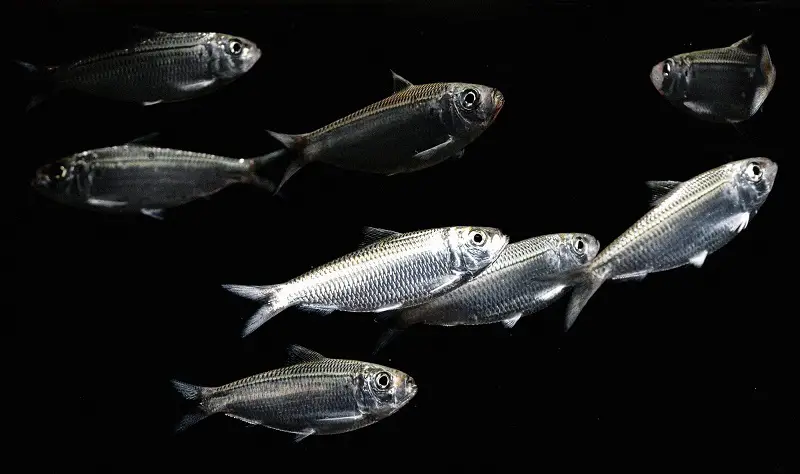
1. Minnows
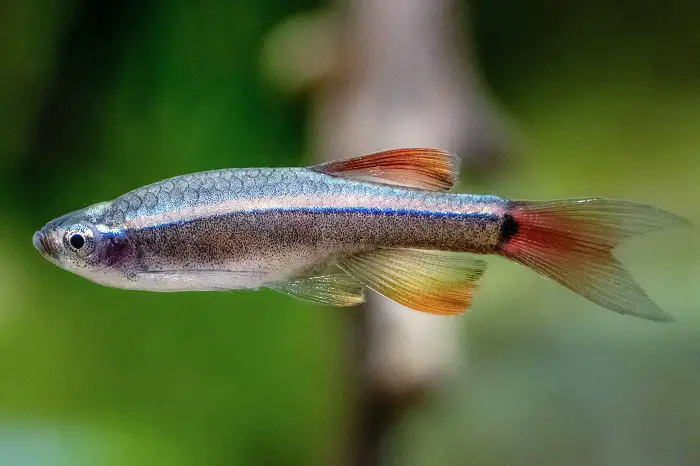
Minnows, those tiny fish that often go unnoticed in freshwater streams and ponds, play a crucial role in the world of fishing. While they may seem insignificant to some, these little creatures have become a sought-after commodity for anglers around the globe. Their ability to attract and entice larger game fish is what makes them so valuable.
One of the most common species used as live bait is the fathead minnow. These hearty little fish can survive in various water conditions, making them an ideal choice for anglers looking to attract a wide range of game fish. The golden shiner is another popular choice among fishermen, known for its vibrant coloration and alluring swimming pattern. And let’s not forget about creek chubs; their ability to wiggle and dart through the water makes them irresistible bait for predatory fish such as pike and catfish.
But it’s not just their usefulness as live bait that makes minnows intriguing. They also have fascinating behaviors that set them apart from other freshwater fish species. For example, fathead minnows are known for their unique courtship displays where males perform elaborate dances to attract females. Additionally, some minnow species exhibit communal nesting behavior, with multiple females depositing eggs in the same location while males guard and care for them.
While minnows might be small in size, they certainly leave a big impact on the world of fishing. Whether you’re an avid angler or simply enjoy observing aquatic life, taking a closer look at these remarkable creatures can be a rewarding experience.
2. Shad
Silver-sided fish are often used for both freshwater and saltwater fishing. Threadfin shad and gizzard shad are commonly used as bait.
Threadfin shad, with their streamlined bodies and shimmering silver scales, make for an irresistible meal for many predator fish. These small but mighty fish have a tendency to form large schools, offering an easy target for anglers looking to catch gamefish like bass and trout. They can be found in lakes, rivers, and estuaries across North America, making them a versatile choice for anglers regardless of their location.
On the other hand, gizzard shad are known for their bony heads and large razor-sharp scales. These hardy creatures can tolerate a wide range of water conditions, including low oxygen levels and high salinity levels. This adaptability makes them a popular bait choice among saltwater fishermen targeting species such as red drum and striped bass. Additionally, gizzard shad are known to hang out near underwater structures like bridge pilings or rocky outcrops, creating hotspots where predatory fish may lurk.
Whether you’re fishing in freshwater or saltwater environments, adding threadfin or gizzard shad to your tackle box could greatly increase your chances of success on the water. Not only do these silvery baitfish possess alluring qualities that attract predator fish from far distances, but they also offer reliability in terms of availability throughout different seasons and locations. So next time you head out on a fishing adventure, consider bringing along some threadfin or gizzard shad as part of your bait arsenal.
3. Herring
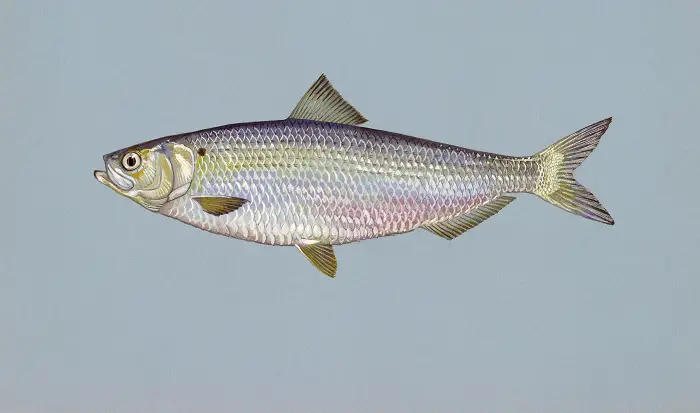
Herring, with their shimmering silver scales and robust oil content, have long been prized by anglers in both saltwater and freshwater environments. Atlantic herring, also known as Clupea harengus, are widely sought after for their rich flavor and versatility in cooking. These fish can be caught in abundance along the Eastern coast of North America during the summer months when they migrate closer to shore.
On the other hand, thread herring (Opisthonema spp.) are popular among anglers in tropical regions where they thrive in warm waters. These sleek and agile fish are known for their distinctive body shape with a slender profile and a slightly upturned mouth. They prefer to swim near the surface of calm bays and estuaries, making them an ideal target for recreational fishermen.
The popularity of herring species extends far beyond their value on the end of a fishing line. Commercially, these oily fish play a crucial role as baitfish or as an ingredient used in various food products such as canned sardines or pickled herrings. Moreover, herring populations serve as significant indicators of marine ecosystem health due to their importance in the food chain – serving as prey for larger predatory species like seals, dolphins, whales and seabirds.
So whether you’re hooking an Atlantic herring off the East Coast or enticing a thread herring on your fishing trip to tropical waters, these silver darlings promise not just an exciting catch but also contribute significantly to our understanding of the complexity and balance of the oceanic environment.
4. Sardines
For many anglers, sardines are a go-to bait when targeting larger saltwater species such as tuna, mackerel, and striped bass. These small, oily fish offer several advantages that make them irresistible to their predatory counterparts. First and foremost is their enticing scent. Sardines exude a strong aroma that can travel through the water for long distances, acting as a powerful attractant for hungry predators in search of an easy meal.
Another key benefit of using sardines as bait is their natural swimming motion. Their quick and darting movements mimic the behavior of injured or fleeing prey, which triggers an immediate response from nearby fish. Anglers often use whole or cut sardines on hooks, allowing them to imitate wounded baitfish effortlessly.
More importantly, incorporating sardines into your fishing strategy can significantly increase your chances of success by attracting not only target species but also other gamefish in the area. Tuna are known to have a voracious appetite for these little fish; therefore, deploying them as live bait or even adding chunks of sardine to chum slicks can create a feeding frenzy that will attract larger predators like sharks.
Overall, it’s clear why anglers rely on sardines when targeting various saltwater gamefish. The combination of their tempting scent and lifelike swimming motion makes them irresistible to predators lurking beneath the surface. So next time you head out for some saltwater fishing action, don’t forget to prepare yourself with some fresh or frozen sardines. These small fish can make a big difference in your fishing success.
5. Mullet
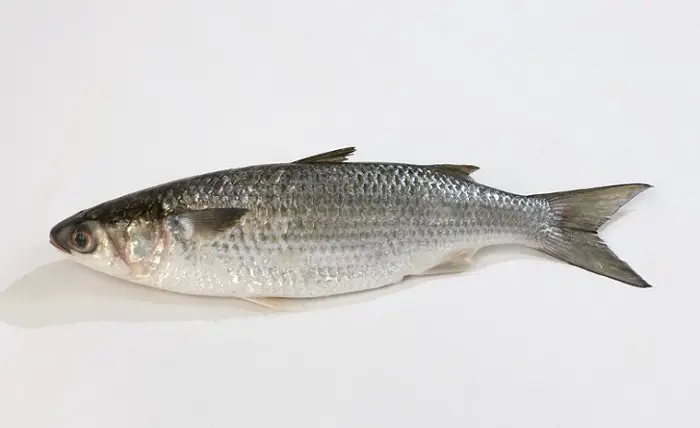
When it comes to baitfish, the mullet is a game changer that is just as effective in saltwater as it is in freshwater fishing. The versatility of this baitfish lies in its ability to adapt to different habitats and its irresistible appeal to a wide range of predatory species. From the finger mullet, which can be found cruising along sandy shores, to the silver mullet that darts through estuaries and coastal waters, these fish have all the attributes needed to entice hungry predators.
One key advantage of using mullet as bait is their natural swimming motion. Unlike some other baits that need constant movement or work on your part, mullets effortlessly glide through the water with their characteristic darting action. This makes them prime targets for large predatory fish such as redfish, tarpon, snook, and even striped bass in freshwater settings. Their lively nature invokes an instinctive feeding response from these species, often leading to explosive strikes that make for unforgettable fishing experiences.
Another interesting aspect about using mullet as bait is their scent-impregnated qualities. These fish emit a distinct odor that predators find hard to resist. The strong aroma acts like a dinner bell for nearby predators searching for an easy meal. Furthermore, the oils released by mullets create an oily slick on the water’s surface, which not only attracts target species but also helps mask any unnatural scents from lures or other baits you might be using.
6. Anchovies
Anchovies, though small in size, play a significant role in both live and preserved forms of fishing. These forage fish are widely used as bait due to their strong scent and flavor. Anglers often turn to anchovies as their go-to bait when trying to attract larger predatory fish.
Not only are anchovies effective as live bait, but they are also commonly used in preserved forms such as salted or canned. The briny taste and soft texture make them ideal additions to various dishes, such as Caesar salads or pizza toppings. In fact, the distinct and pungent flavor of anchovies is either loved or hated by many – there’s no gray area when it comes to these tiny fish!
While some may consider anchovies merely a topping or an ingredient in Mediterranean cuisine, they hold a deeper significance beyond their culinary uses. Anchovies thrive in large schools near the surface of the ocean, making them important indicators of the overall health of marine ecosystems. Monitoring their populations can provide valuable insights into the ecological balance and help protect other species that depend on similar habitats for survival.
Whether you’re an angler using them as live bait or a food lover appreciating their unique taste in diverse dishes, anchovies deserve more recognition for their versatility and ecological importance than we often give them credit for. By understanding how they contribute both to our recreational activities and our understanding of marine ecosystems, we can truly appreciate these small but mighty creatures found beneath the waves.
7. Menhaden
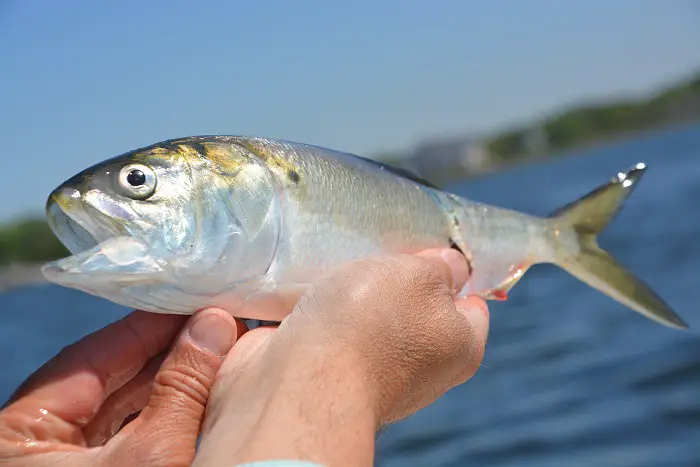
Menhaden, also known as the most important fish in the sea, may not be as glamorous or well-known as other popular game fish, but their impact on the fishing industry cannot be overlooked. These small, silvery fish are highly sought after for their oil and protein-rich bodies.
Menhaden oil is widely used for producing omega-3 supplements and other fish oil products due to its high levels of heart-healthy fatty acids. Meanwhile, menhaden meal serves as a valuable source of protein for livestock and aquaculture feed.
Interestingly, menhaden have played a crucial role in maintaining ecosystem balance along the Atlantic coast. The large schools of these oily fish often swim close to shorelines where they filter-feed on plankton, effectively removing excess nutrients from the water.
This helps prevent harmful algal blooms, which can lead to oxygen depletion and ecological damage. Menhaden’s ecological importance has sparked intense debate between conservationists advocating for strict catch limits to protect their population size and commercial fishermen who rely on catching them in large quantities.
Despite being commonly used in various industries, menhaden also serves another purpose closer to home: as cut bait for recreational fishing enthusiasts targeting game fish such as striped bass or bluefish.
The strong odor that accompanies freshly cut menhaden acts like a magnet, attracting larger predatory fish that are lured by the scent trail it leaves behind. It’s interesting how something so unassuming can become a dynamic tool in both commercial and recreational fisheries alike.
8. Pilchards
Pilchards, also known as sardines, are a staple for saltwater fishing enthusiasts. Their small size and silvery color make them irresistible to game fish like tarpon, snook, and jacks. These little fish can be found in vast numbers along coastal areas, forming massive schools that attract the attention of predatory species.
One interesting aspect about pilchards is their feeding behavior. They are voracious eaters and consume plankton and other microscopic organisms found in the water column. This makes them an abundant source of food for larger predatory fish that rely on them for sustenance. Interestingly, these tiny fish have a unique way of moving through the water – they swim together in unison, creating an illusion of a bigger organism. It is believed that this synchronized movement helps them confuse their predators and increase their chances of survival.
Another fascinating thing about pilchards is their reproductive habits. They have high fertility rates and can reproduce rapidly under favorable conditions. When it’s time to spawn, large groups gather near shorelines or in estuaries where there is plenty of food and shelter for their young ones. This creates a feeding frenzy among game fish as they take advantage of the abundance of prey during these times.
Pilchards play a crucial role in saltwater fishing as they attract some of the most sought-after game fish species. Their unique feeding behavior and reproductive habits make them an intriguing subject for fishermen looking to understand more about the marine ecosystem. So next time you’re out on the water, keep an eye out for the telltale signs of a pilchard frenzy. Look for diving birds, splashing water, and swirling baitfish near shorelines or estuaries. These are all indicators that game fish are feeding on pilchards.
9. Ballyhoo
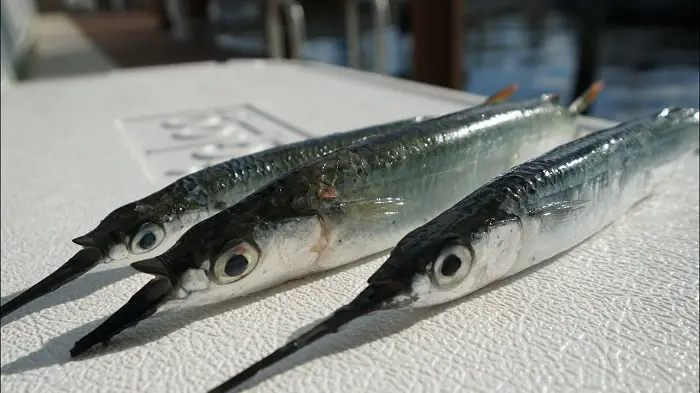
Ballyhoo, a small baitfish found in warm ocean waters, is a staple in the world of saltwater fishing. Its popularity lies not only in its abundance but also in its effectiveness as bait for trolling and offshore angling. These sleek and vibrant fish are known to attract larger game fish such as tuna, marlin, and sailfish.
One fascinating aspect of ballyhoo fishing is the art of rigging them on hooks. Anglers have developed various techniques to present these baits in the most enticing way possible. From rigged swimming baits to nose-rigged dead baits, each method has its own advantages and can attract different types of fish species depending on how it mimics their natural prey.
Another interesting fact about ballyhoo is their extraordinary ability to leap out of the water when hooked by a line. This acrobatic display not only excites anglers but also alerts other predators nearby that there could be an easy meal waiting for them. This behavior creates a feeding frenzy around the hooked fish, increasing your chances of catching larger game fish that are drawn to the commotion.
The ballyhoo is more than just another fish used for bait; it’s a dynamic creature that adds excitement and potential success to every saltwater fishing adventure. Whether you’re trolling or engaging in offshore angling, incorporating ballyhoo into your fishing arsenal opens up a world of possibilities for reeling in trophy-sized catches while enjoying the adrenaline rush that comes with the chase. Ballyhoo’s vibrant colors and darting movements make it an irresistible target for predatory fish, making it a go-to bait for experienced anglers seeking big games. Its versatility is another reason why ballyhoo has gained popularity among saltwater fishermen.
10. Cigar Minnows
Cigar minnows, often mistaken for ballyhoo due to their similar appearance, are a staple in the world of offshore fishing. These small fish pack a punch when it comes to attracting bigger game fish such as tuna and mahi-mahi. Captivating not only in their use as bait but also in their unique behavior, cigar minnows are truly fascinating creatures of the sea.
One interesting aspect of cigar minnows is their schooling behavior. These fish can be found swimming together in large groups, creating a spectacle that attracts predators from miles away. Their silvery bodies shimmering under the sunlight create an irresistible target for larger fish looking for an easy meal. This makes them incredibly effective as bait, as they can quickly grab the attention of hungry game fish.
In addition to their ability to attract predatory species, cigar minnows also possess remarkable speed and agility. Despite their small size, these little powerhouses are known for their swift and sudden movements. When hooked and used as live bait, they put up quite a fight on the line before being devoured by bigger predators lurking beneath the surface. Their lively nature adds a thrilling dimension to offshore fishing, bringing excitement and anticipation to every angler lucky enough to have them on board.
Cigar minnows may be similar in appearance to ballyhoo but offer unique qualities that make them excellent choices for offshore fishing bait. Not only do they boast eye-catching appearances that attract larger game fish from afar, but they also have a strong scent that can entice even the most cautious predators. The combination of their vibrant colors and enticing aroma make cigar minnows irresistible to big game fish, making them an essential bait for any serious angler.
11. Squid
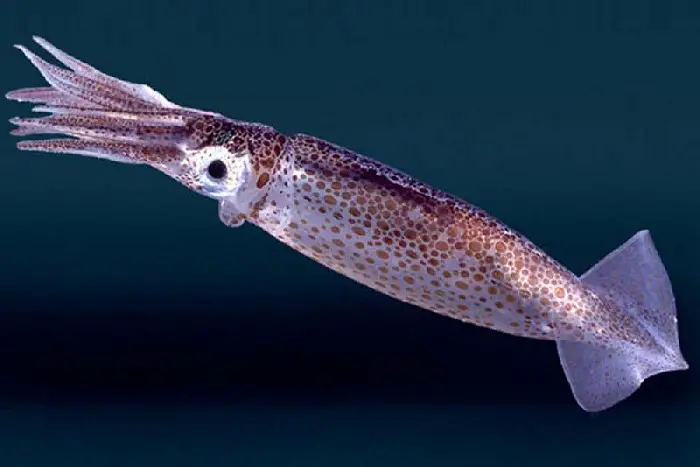
It’s not a fish, but a cephalopod, squid is used as both live and cut bait for a variety of saltwater species. With their sleek bodies and vibrant colors, squids have long been an enticing treat for hungry predators lurking beneath the ocean’s surface. While many anglers may be familiar with using artificial lures or baitfish as their go-to bait option, there’s something about presenting a fresh squid that can make all the difference in hooking trophy fish.
One of the main advantages of using live squid as bait is its realistic appearance in the water. Unlike some artificial lures which can look too perfect to fool wise old fish, a lively squid has natural movements that mimic injured prey and attract predator fish looking for an easy meal. The undulating tentacles and translucent body create a lifelike presentation that can entice even the most wary species.
Cut squid, on the other hand, offers another approach to enticing saltwater gamefish. Whether it’s strip baits or whole sections threaded onto hooks, chunks of squid can release irresistible scent trails into the water to draw in hungry predators from afar. Many anglers swear by its effectiveness when targeting bottom-dwelling species such as flounder or grouper, as well as pelagic predators like tuna and marlin who are drawn to the commotion caused by chunks sinking through their hunting grounds. So next time you’re heading out for a saltwater fishing adventure, don’t forget to give squid a try.
12. Sand Eels
Sand eels, also known as sand lance, are small, slender fish that play a crucial role in the marine ecosystem. They are often found buried in the sandy seabed along coastal areas. Despite their size, these unassuming creatures have a significant impact on many larger predatory species, serving as an essential source of sustenance.
What makes sand eels so sought after by fishermen is their irresistible appeal to prized game fish like striped bass and bluefish. These predatory species rely heavily on sand eels for their diet due to their high energy content. The narrow bodies of sand eels allow them to move through the water with remarkable agility, making them highly attractive targets for game fish tracking prey.
However, it’s not just anglers who find these little fish fascinating. Sand eels have even caught the attention of researchers investigating underwater ecosystems and food chains. By studying populations of sand eels and how they interact with other species, scientists are gaining invaluable insights into the delicate balance that sustains marine life.
While they may be small in size, sand eels play a mighty role in both our fishing traditions and the wider marine ecosystem. Their importance as prey for predator species highlights their significance in sustaining healthy populations throughout coastal regions. As we continue to learn more about these captivating creatures, let us not forget to appreciate their vital contribution to the intricate web of life beneath the waves.
13. Smelts
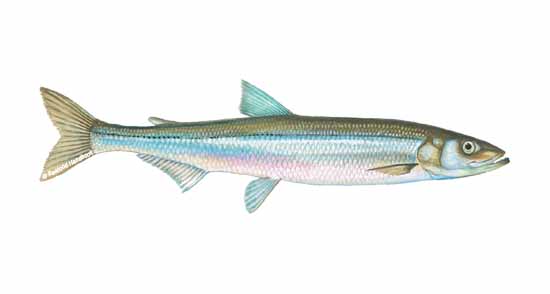
Smelts, those small, silvery fish that often go unnoticed by anglers, are a secret weapon in the world of fishing. These little swimmers serve as an irresistible treat for larger predatory fish like trout, salmon, and stripers. Whether you’re casting your line in freshwater or saltwater, using smelts as bait can greatly increase your chances of success.
What makes smelts so alluring to these gamefish? It’s their size and appearance. Smelts typically measure around 3 to 6 inches in length and possess a slim profile with a shiny silver coloration. This mimics the look of smaller baitfish that larger predators frequently feed on. By harnessing the natural instincts of their prey, fishermen can entice some truly impressive catches with these tiny but mighty baits.
Not only do smelts attract fish due to their visual appeal, but they also emit a distinct scent that acts as an olfactory magnet for predators. Their oil-rich flesh releases an enticing aroma underwater that lures nearby gamefish. This natural scent trail helps fish zero in on the source and strike aggressively when presented with a smelt baited hook.
Furthermore, because of their abundance in many regions and ease of procuring or catching yourself – if regulations permit – using live or fresh-smelling dead smelts is both cost-effective and environmentally friendly compared to other commercially available bait options.
So next time you head out on a fishing adventure targeting species like trout, salmon, or stripers, remember this hidden gem and bring along a handful of smelts. Not only will you increase your chances of landing a trophy fish, but you’ll also be contributing to the sustainable fishing practices that many anglers strive for.
14. Crawfish/Crayfish
Did you know that crawfish, also known as crayfish, are not just tasty seafood but also commonly used as bait for fishing? These freshwater crustaceans are a popular choice for anglers targeting species like bass and catfish. With their strong scent and enticing movement, crawfish can be a tempting treat for fish in both natural and artificial environments.
One interesting aspect of using crawfish as bait is their ability to attract larger predators. The predatory nature of bass and catfish makes them drawn to the presence of these small creatures on their menus. The vibrant colors and subtle motions of live or artificial crawfish imitations provide an excellent opportunity for anglers to entice more activity from their targeted fish species.
Not only do crawfish serve as effective bait, but they also reveal valuable insights into the underwater ecosystem. By observing which types of fish are attracted to these crustaceans, fishermen gain knowledge about the local food chain dynamics. This information helps determine the health and abundance levels of certain predator species, providing vital data for conservation efforts.
It’s fascinating to see how versatile crawfish are in the world of fishing. From being a delicious seafood option to serving as an effective bait for catching larger predator fish, these crustaceans play multiple roles in our angling experiences. Moreover, through their use in baiting methods, we can learn more about the delicate balance within aquatic ecosystems – ultimately aiding in preserving our precious natural resources. So next time you head out on a fishing adventure, consider giving crawfish a try as bait. Not only will you increase your chances of landing that prized trophy fish, but you’ll also contribute to the understanding and conservation of our aquatic ecosystems. Remember to check local regulations and obtain necessary permits before collecting or using crawfish as bait.
15. Leeches
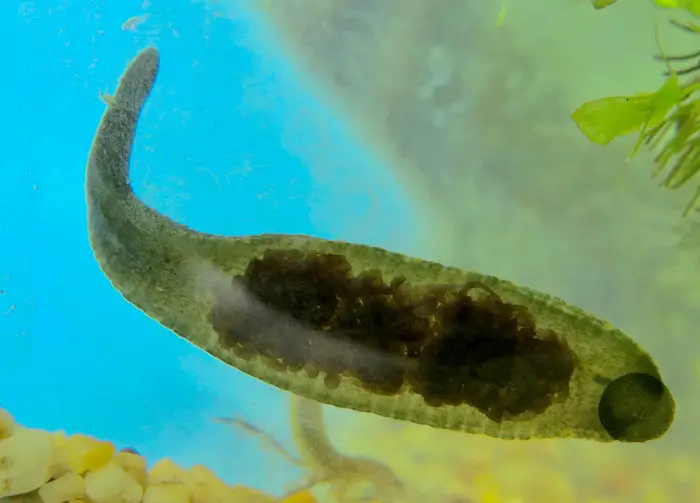
These slimy, blood-sucking creatures may not be the most appealing of creatures to look at, but when it comes to fishing, leeches are a highly effective and popular choice for live bait. Beloved by anglers targeting walleye, bass, and panfish, these aquatic worms have a unique allure that fish simply can’t resist.
It’s not just their notorious reputation as relentless bloodsuckers that make leeches so enticing; it’s also their natural movement in the water that mimics injured prey. This provides an irresistible temptation for hungry fish lurking beneath.
Leeches have been used in fishing for centuries and continue to be a go-to option for many experienced anglers. They are particularly successful when fished on hooks with minimal weight or floated beneath bobbers, allowing them to display their natural wriggling motion.
Furthermore, the secret weapon of using leeches lies not only in their ability to attract fish but also in their durability as live bait. Unlike other options such as minnows or nightcrawlers which can easily die on the hook after extended periods without oxygen or water contact, leeches can remain lively for hours underwater.
Despite being widely recognized as excellent live bait options for certain species of fish, some may question the ethics of using these bloodthirsty worms solely for our own entertainment purposes.
However, it’s important to note that leech populations are typically abundant in freshwater environments, and harvesting them from nature has minimal impact on the overall ecological balance. Additionally, using leeches as bait can actually be beneficial for both the angler and the ecosystem.
By utilizing leeches as live bait, anglers are able to attract a wider range of fish species. This not only enhances their fishing experience but also helps maintain healthy fish populations. In some cases, certain fish species may specifically rely on leeches as a primary food source in their natural habitats.
16. Worms
One might think that worms are just slimy creatures crawling in the dirt, but when it comes to freshwater fishing, they can be a game-changer. Common earthworms and nightcrawlers are two types of worms that have gained popularity among anglers for their effectiveness in attracting fish.
These worms are known as live bait because they are wriggling with life, which triggers the predatory instinct of many fish species. Their movement combined with the scent they emit creates an irresistible combination that lures fish towards your hook. And it’s not just small species; even larger predators like bass and catfish find these humble creatures hard to resist.
However, using live worms as bait requires some skill and finesse. It is essential to thread them onto the hook properly to ensure maximum movement underwater. Additionally, keeping them alive and well-nourished until you hit the water is crucial for optimal performance. This means proper storage in a cool and moist environment before your fishing trip.
Next time you head out on a freshwater fishing adventure, don’t forget about the power of these ordinary yet extraordinary creatures. Whether you opt for common earthworms or nightcrawlers, these tiny wrigglers could be your ticket to reeling in that big catch you’ve been dreaming of. So grab some tackle boxes filled with fresh baits and get ready for a memorable day on the water.
17. Shrimp
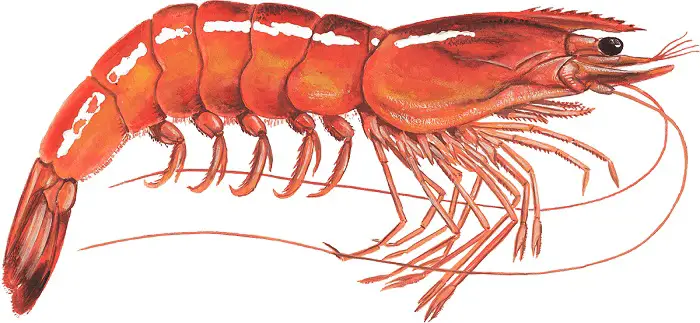
Shrimp have long been recognized as one of the most versatile baits for both saltwater and freshwater fishing. They possess an irresistible scent and flavor that can entice a wide range of species. Whether you are targeting redfish in the marshes or trout in a mountain stream, shrimp will undoubtedly be effective.
One interesting aspect of using shrimp as bait is their ability to mimic natural food sources. Shrimp are found in various habitats, such as coastal marshes, estuaries, and even deep offshore waters. As a result, many fish have become accustomed to feeding on these crustaceans. By presenting them with a live or artificial shrimp lure, anglers effectively imitate their prey’s appearance and movement, increasing their chances of getting a bite.
Another advantage of using shrimp as bait is their versatility in presentation. Anglers can rig live shrimp under popping corks, allow them to drift naturally with the current on a Carolina rig, or use them on a jig head for casting and retrieving techniques. This flexibility allows fishermen to adapt to different fishing conditions and target species with great success.
It’s no wonder why shrimp remain popular among anglers worldwide – they simply work! The combination of enticing scents, natural mimicry, and versatile presentations make them an indispensable tool for any angler’s tackle box. So next time you hit the water in search of that trophy fish, don’t forget to stock up on some fresh or frozen shrimp – your success might just depend on it.
18. Crabs
Crabs are not only fascinating creatures to observe, but they also play a vital role in the world of fishing. Blue crabs, fiddler crabs, and various other small crab species have become popular choices when it comes to baiting fish like redfish and black drum. Their strong scent and wriggling movements underwater make them irresistible to these predatory species.
One interesting aspect is that different crabs attract different fish species. For example, blue crabs are known for enticing redfish due to their lively display underwater. Their vibrant blue shells coupled with their fluttering motions create an enticing spectacle that few redfish can resist. On the other hand, fiddler crabs are sought after by black drum as they prefer the subtle scuttling motion of these smaller crustaceans.
Using live crabs as bait requires some skill and finesse from anglers who want to lure in these larger game fish successfully. To increase their chances of success, many experienced fishermen even go as far as imitating the natural behavior of these small crabs while using artificial lures to mimic their appearance and movement accurately.
When it comes to fishing for species like redfish and black drum, utilizing live crabs such as blue crabs or fiddler crabs can elevate your chances of a successful catch. Understanding the preferences of each target species regarding crab size, coloration, and movement patterns will provide you with an edge on your next angling expedition.
So next time you head out on the water, consider bringing along some live crabs as bait and experiment with different sizes, colors, and movement techniques to see what works best for the fish you are targeting. Remember to handle the crabs carefully and keep them alive until you are ready to use them. With a little patience and skill, you may just reel in your biggest catch yet. Happy fishing.
19. Ghost Shrimp

Ghost shrimp may be small, but they play a big role in the world of fishing. Speckled trout and flounder aren’t the only species that find these sand-dwelling crustaceans irresistible; pompano and sheepshead are also known to go crazy for them. As seasoned anglers know, using live bait is often the key to success, and ghost shrimp make for an excellent choice.
What makes ghost shrimp so effective as bait? One reason is their uncanny ability to bury themselves in the sand, mimicking natural prey behavior. This not only attracts predatory fish but also adds an element of surprise when they suddenly emerge. Additionally, their soft bodies make them vulnerable targets – perfect for tempting even the pickiest eaters.
There’s something almost magical about watching a fish strike at your line right after you’ve dropped a live ghost shrimp into the water. The anticipation builds as you feel your line tighten with each nibble. This unique experience is part of what makes targeting pompano or sheepshead with ghost shrimp such a thrill for any angler fortunate enough to have discovered its effectiveness.
As anglers continue to uncover new strategies and techniques, one thing remains clear: ghost shrimp are more than just bait; they are secret weapons in the pursuit of elusive fish species like pompano and sheepshead. So next time you hit the beach or embark on a chartered fishing trip, consider adding these little crustaceans to your tackle box – who knows what amazing catches you might reel in with the help of ghost shrimp.
20. Grass Shrimp
Grass shrimp, also known as ghost shrimp, may be one of the smallest creatures in the aquatic world, but they play a vital role in both freshwater and saltwater fishing. These tiny, transparent crustaceans are an incredibly popular bait for anglers targeting a wide variety of game fish. And it’s not difficult to see why – their natural appearance and movement in water make them irresistible to predatory fish.
One intriguing aspect of grass shrimp is their ability to survive in various habitats. They can flourish in shallow freshwater ponds as well as brackish marshes along coastal areas. This versatility opens up countless opportunities for fishermen searching for different species and fishing locations. Whether you’re chasing trout in a mountain stream or targeting redfish on the flats, these little shrimps can be your secret weapon.
Furthermore, using grass shrimp as bait offers an element of surprise that sets it apart from more commonly used baits like worms or minnows. Many anglers have witnessed how fish often show special interest in these transparent creatures when presented with other options.
The subtle movements they exhibit while swimming through the water evoke curiosity and temptation among fish species such as striped bass, speckled trout, and even largemouth bass. So next time you head out on your fishing adventure, consider adding some grass shrimp to your arsenal – you never know what surprises await.
✅ How to Choose the Right Bait Fish for Your Target Species
Choosing the right bait fish for your target species is crucial to increasing your chances of a successful fishing trip.
The first step is evaluating the habitat and feeding habits of the fish you are targeting.
Different species have different preferences when it comes to food, so understanding their diet can help you select the most effective bait.
Another important factor is the size and movement of the bait fish. Match your bait’s size with what your target fish typically feeds on.
If they primarily consume small minnows, using larger bait may not yield good results. Pay attention to how the prey moves as well; some fish are attracted to fast-moving baits while others prefer slow, subtle motions.
Additionally, consider the availability and freshness of the bait fish in your area. Using locally sourced and fresh live bait can make a significant difference in attracting your desired catch.
Observe local fishing reports or talk to fellow anglers about which types of bait have been successful recently.
Selecting the right bait fish involves understanding your target species’ feeding habits, matching their preferred size and movement patterns, as well as considering local availability and freshness of live baits.
By carefully choosing appropriate baits based on these factors, you can significantly increase your chances of hooking that trophy catch during your next fishing expedition!
Types of Bait Fish (Summary)
Understanding the different types of bait fish can greatly enhance your fishing experience.
Whether you are targeting largemouth bass in freshwater or marlin in the open ocean, having the right bait is crucial.
From minnows and shiners to herring and mackerel, each type of bait fish offers unique characteristics that can attract and entice various species.
By studying the habits and preferences of your target fish, as well as experimenting with different bait options, you can increase your chances of success on your next fishing trip.
So next time you hit the water, be sure to stock up on a variety of bait fish and see how it improves your catch rate.
Other Blog Posts